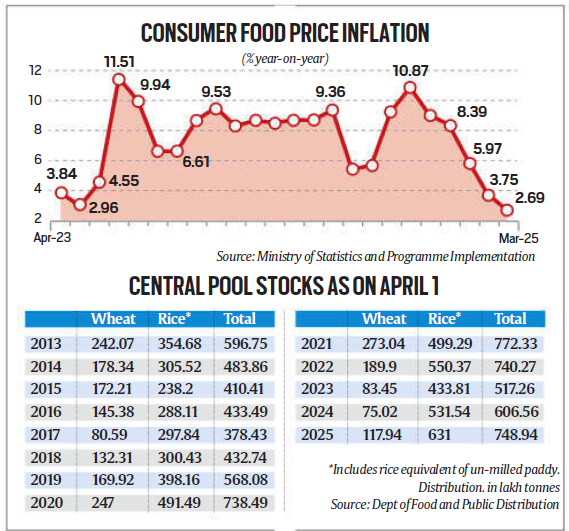El Niño Disrupts, La Niña Stabilizes: India’s Agri and Inflation Outlook
(Source – Indian Express, Section – Explained, Page – 14)
|
Topic: GS3 – Indian Economy |
|
Context |
|
 Analysis of the news:
Analysis of the news:
Unusual Ocean Warming and Weather Anomalies
-
The 2023–24 El Niño event was both prolonged and intense, with sea surface temperatures off the coasts of Ecuador and Peru rising up to 2°C above the 30-year average.
-
This significantly exceeded the 0.5°C threshold for El Niño classification, severely impacting weather patterns across the globe, including India.
Disrupted Monsoons and Agricultural Distress
-
El Niño led to deficient rainfall during India’s monsoon, post-monsoon, and winter seasons.
-
Delayed winters and excessive heat from March 2024 severely hit both kharif and rabi crop yields, resulting in a poor agricultural year.
-
Subpar crop output contributed directly to food inflation and economic stress.
Prolonged Food Inflation and Dampened Consumption
-
Food inflation averaged over 8.5% between July 2023 and December 2024 — one of the longest such spells in recent memory.
-
This ate into household budgets, reducing discretionary spending. FMCG sector growth stalled, reflecting reduced consumer demand.
Turnaround with Mild La Niña and Better Weather
-
The beginning of 2024 saw cooling Pacific waters, indicating mild La Niña-like conditions.
-
This contributed to improved rainfall and weather, boosting rabi harvests and easing food inflation to 2.7% in March — the lowest since November 2021.
Wheat Situation: From Scarcity to Surplus
-
Wheat stocks had dipped to a 16-year low, but the 2024 harvest saw a turnaround, especially in central India.
-
Favorable weather and adoption of high-yielding varieties led to a bumper crop, stabilizing prices and strengthening government stocks.
Optimistic Outlook: Above Normal Monsoon Forecast
-
The IMD has forecast an above-normal monsoon (105% of the long period average) for June–September 2025, with ENSO-neutral conditions expected.
-
Alongside falling global oil prices and a weakening dollar, this presents a “positive terms of trade shock” — potentially boosting consumption and easing macroeconomic pressures.
Conclusion:
-
While El Niño wreaked havoc on agriculture and food prices, improved climatic conditions, resilient farming practices, and supportive global trends signal a recovery phase — offering hope for inflation control and renewed economic momentum.
|
Practice Question: Discuss the impact of the 2023–24 El Niño event on India’s agriculture, food inflation, and overall economy. How can India build resilience against such climate-induced disruptions in the future?. (250 Words /15 marks) |
